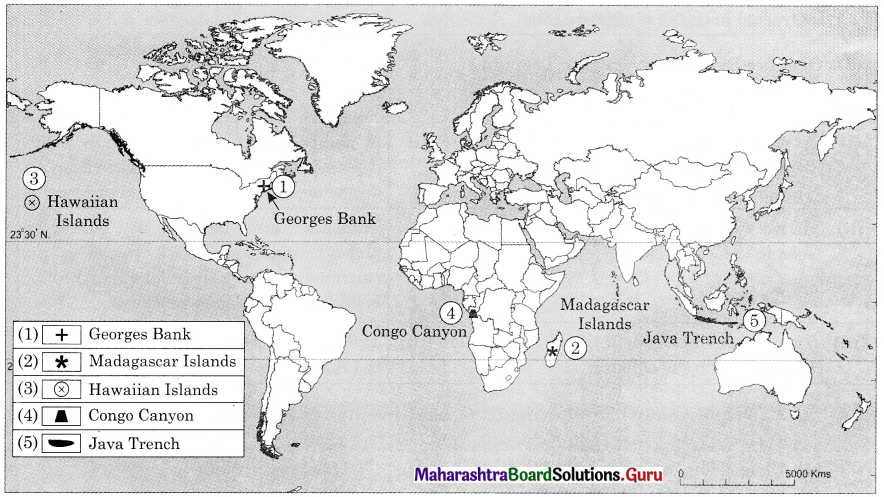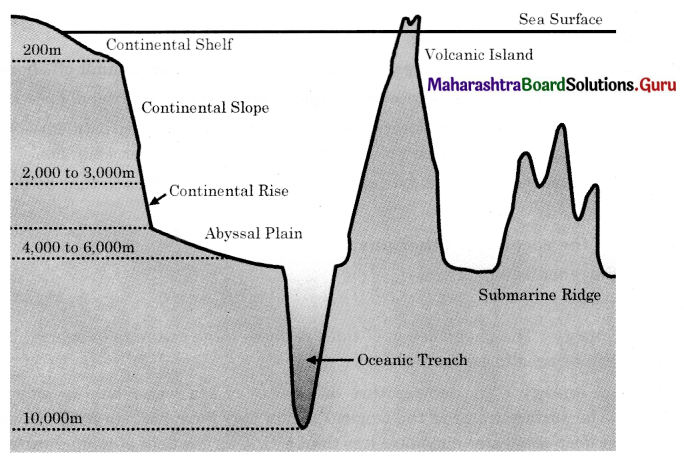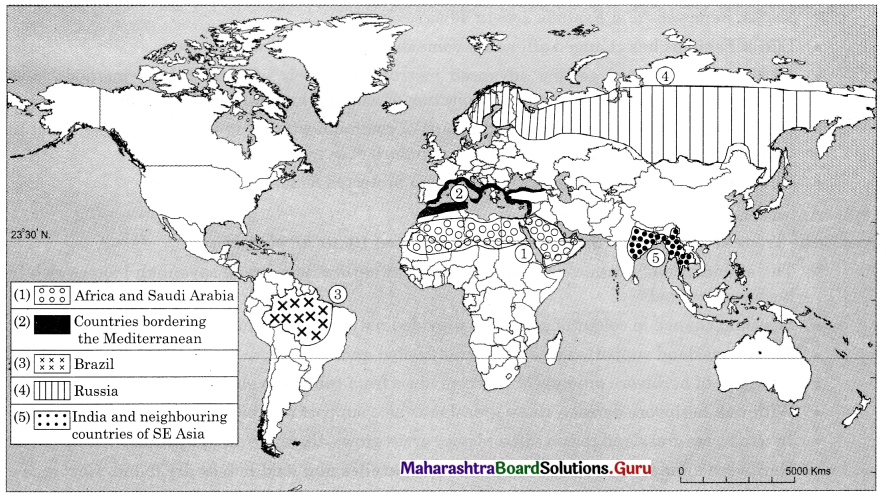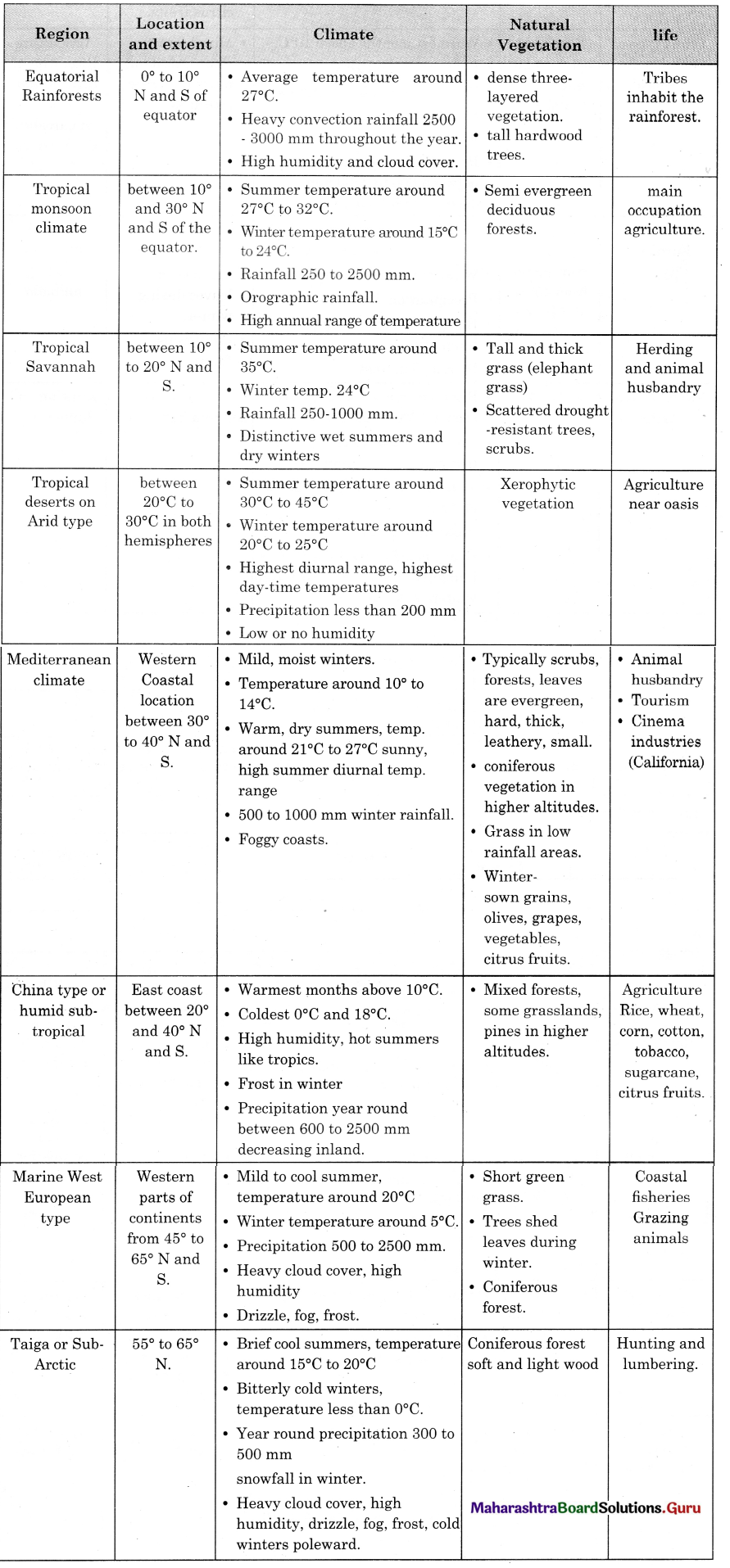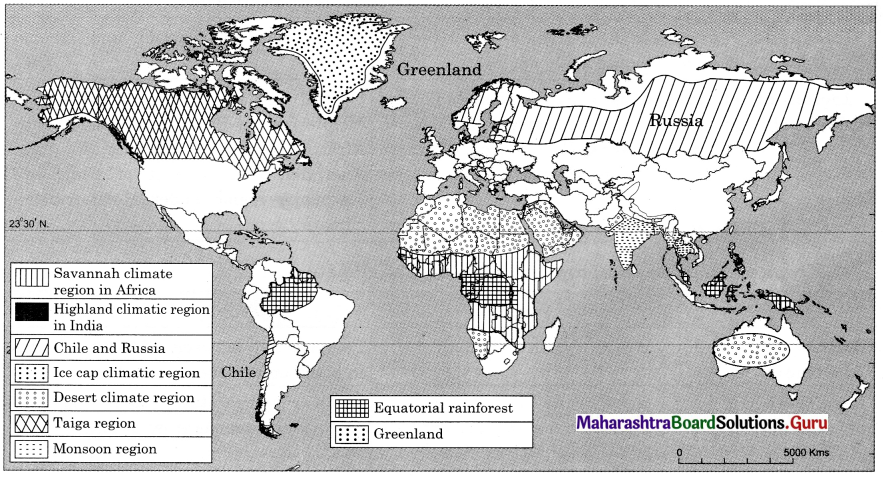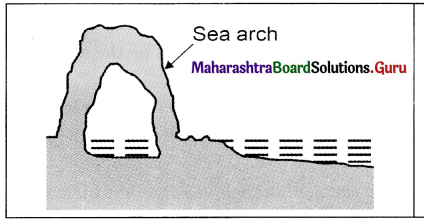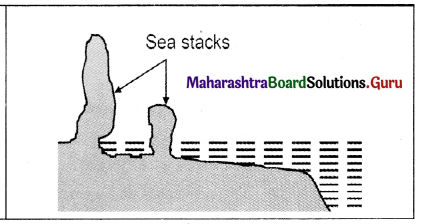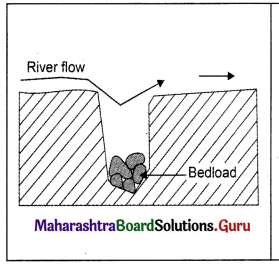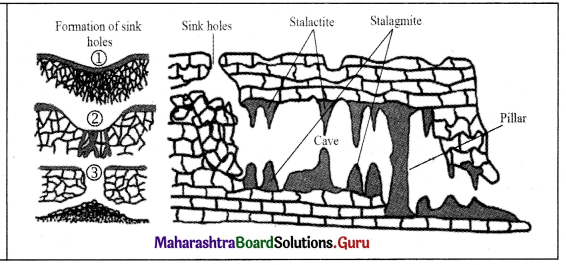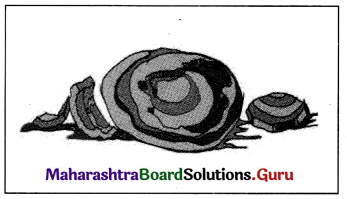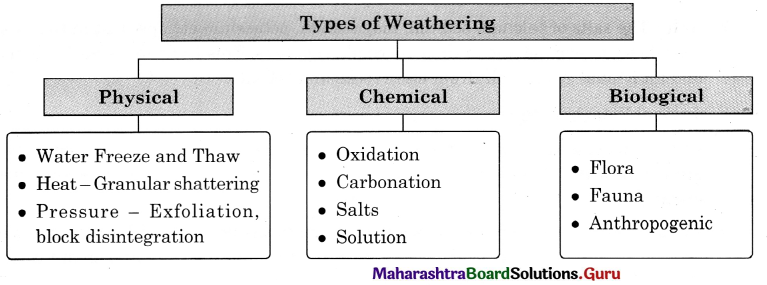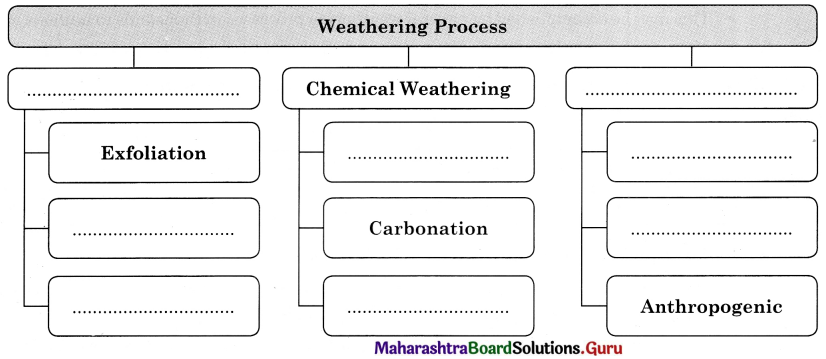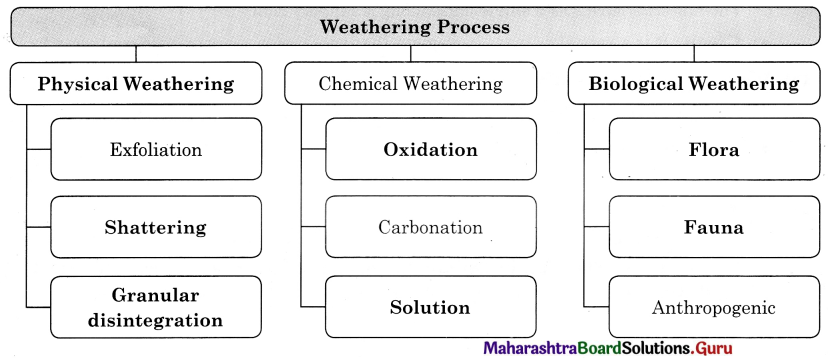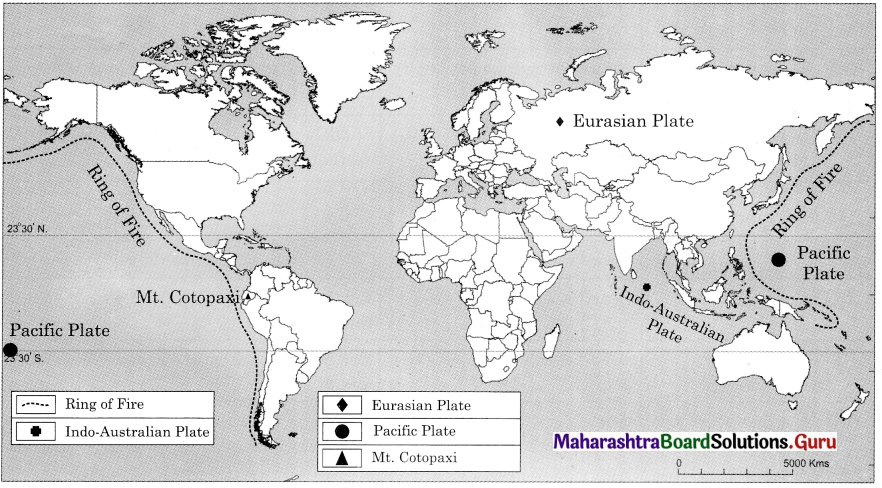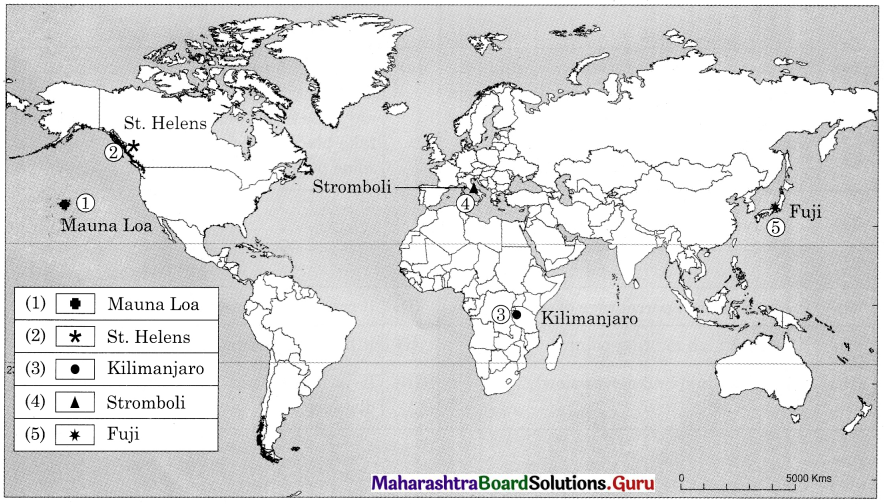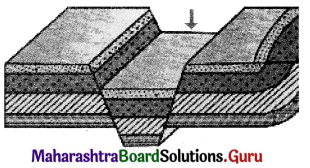Balbharti Maharashtra State Board Class 11 Geography Important Questions Chapter 7 Indian Ocean – Relief and Strategic Importance Important Questions and Answers.
Maharashtra State Board 11th Geography Important Questions Chapter 7 Indian Ocean – Relief and Strategic Importance
Complete the chain.
Question 1.
| A | B | C |
| (1) Continental shelf | (1) Archipelagos formed by coral atolls | (1) Very wide on the western side of India |
| (2) Mid-Oceanic Ridges | (2) Portion of continent submerged underwater | (2) Ashmore |
| (3) Oceanic Plateaus | (3) Submerged mountain ranges that separate deep portions of the ocean floor | (3) the Ninety East Ridge |
| (4) Islands | (4) Deep flat areas on the ocean bottom | (4) Chagos |
Answer:
| A | B | C |
| (1) Continental shelf | (1) Portion of continents submerged underwater | (1) Very wide on the western side of India |
| (2) Mid-Oceanic Ridges | (2) Submerged mountain ranges that separate deep portions of the ocean floor | (2) Ninety East Ridge |
| (3) Oceanic Plateaus | (3) Deep flat areas on the ocean bottom | (3) Chagos |
| (4) Islands | (4) Archipelagos formed by coral atolls | (4) Ashmore |
![]()
Complete the table.
Question 1.
The Indian Ocean bordered by
| Sr. No | Direction | Continents / Oceans |
| (1) | West | —– |
| (2) | North and East | —– |
| (3) | East | —– |
| (4) | South | —– |
Answer:
| Sr. No | Direction | Continents / Oceans |
| (1) | West | Africa |
| (2) | North and East | Asia |
| (3) | East | Australia |
| (4) | South | Southern Ocean |
Question 2.
Bottom Relief of the Indian Ocean
| Sr. No | Features | Comprise of |
| (1) | Continental Shelf | —– |
| (2) | Mid-oceanic Ridges | —– |
| (3) | Ocean Basins | —– |
| (4) | Oceanic Deeps | —– |
| (5) | Islands | —– |
Answer:
| Sr. No | Features | Comprise of |
| (1) | Continental Shelf | Gulf, seas, bays and straits |
| (2) | Mid-oceanic Ridges | Submerged mountain ranges and plateaus |
| (3) | Ocean Basins | Terminal destinations for the sediments brought from the continents and from the oceanic part itself. |
| (4) | Oceanic Deeps | Deep, narrow and steeply sloping depressions found on the ocean floor |
| (5) | Islands | Coral atolls and volcanic islands |
Question 3.
Islands of Indian Ocean
| Sr. No | Islands of Indian Ocean: | |
| (1) | Islands in the Arabian Sea | ——— |
| (2) | Islands of Bay of Bengal | ——— |
| (3) | Islands along Australian Coast | ——— |
Answer:
| Sr. No | Islands of Indian Ocean: | |
| (1) | Islands in the Arabian Sea | Madagascar, Comoros, Bassas de India, Europa Island, Reunion, Maldives, Chagos, Mauritius, Seychelles, Island of Socotra, Lakshadweep, Bundle Island, Kish, Hendorabi, Lavan, Siri, etc. |
| (2) | Islands of Bay of Bengal | Sri Lanka, Andaman and Nicobar, Sumatra Island |
| (3) | Islands along Australian Coast | Ashmore, Christmas and Cocos (or Keeling) Island. |
Choose the correct option by identifying the correct correlation in the sentences.
Question 1.
Most of the trenches of the Indian Ocean are located towards its ………………… boundary.
(a) northern
(b) southern
(c) eastern
(d) western
Answer:
(c) eastern
Question 2.
The Bundle Island is located near the coast of …………………….
(a) Sri Lanka
(b) Pakistan
(c) Bangladesh
(d) Myanmar
Answer:
(b) Pakistan
![]()
Question 3.
To the east of …………………. lie the islands like Reunion, Mauritius, Seychelles, Socotra.
(a) Madagascar
(b) Australia
(c) Indonesia
(d) Sri Lanka
Answer:
(a) Madagascar
Question 4.
Diego Garcia is an atoll which was first discovered by the Europeans and named by the ……………………
(a) Portuguese
(b) French
(c) Dutch
(d) Germans
Answer:
(a) Portuguese
Question 5.
The salinity of the oceans is generally …………………. around the Somali Peninsula and closer to the Saudi Arabian Coast.
(a) high
(b) low
(c) moderate
(d) very high
Answer:
(a) high
Question 6.
The South Equatorial current flows from / in the ……………………
(a) west to east
(b) east to west
(c) clockwise direction
(d) anticlockwise direction
Answer:
(b) east to west
Identify the correct correlation.
A : Assertion
R : Reasoning
Question 1.
A – There is a complete blockage of the Indian Ocean towards its north.
R – Unlike the Pacific Ocean and the Atlantic Ocean the Indian Ocean does not extend northwards to the Arctic Ocean.
(a) Only A is correct.
(b) Only R is correct.
(c) Both A and R are correct and R is the correct explanation of A.
(d) Both A and R are correct but R is not the correct explanation of A.
Answer:
(c) Both A and R are correct and R is the correct explanation of A.
![]()
Question 2.
A – It is believed by most of the geologists that Madagascar was a part of African Continent in the geological past.
R – It has undergone two separations such as first separation from Africa and later from the Indo-Australian Plate.
(a) Only A is correct.
(b) Only R is correct.
(c) Both A and R are correct and R is the correct explanation of A.
(d) Both A and R are correct but R is not the correct explanation of A.
Answer:
(c) Both A and R are correct and R is the correct explanation of A.
Question 3.
A – In the case of Bay of Bengal, the Peninsular rivers lead to the lowering of salinity in this area.
R – The salinity is less during the period of South West Monsoon.
(a) Only A is correct.
(b) Only R is correct.
(c) Both A and R are correct and R is the correct explanation of A.
(d) Both A and R are correct but R is not the correct explanation of A.
Answer:
(d) Both A and R are correct but R is not the correct explanation of A.
Question 4.
A – The Indian market has emerged as one of the largest importers of South East Asian goods.
R – The recently concluded Free Trade Agreements with countries like Thailand and Singapore are set to contribute to this trend.
(a) Only A is correct.
(b) Only R is correct.
(c) Both A and R are correct and R is the correct explanation of A.
(d) Both A and R are correct but R is not the correct explanation of A.
Answer:
(d) Both A and R are correct but R is not the correct explanation of A.
Identify the incorrect factor.
Question 1.
The islands in Bay of Bengal are-
(a) Andaman and Nicobar
(b) Sri Lanka
(c) Sumatra
(d) Madagascar
Answer:
(d) Madagascar
Question 2.
The islands in the Arabian Sea are-
(a) Sumatra
(b) Mauritius
(c) Seychelles
(d) Chagos
Answer:
(a) Sumatra
![]()
Question 3.
The islands along the Australian coast are-
(a) Maldives
(b) Ashmore
(c) Christmas
(d) Cocos
Answer:
(a) Maldives
Question 4.
Islands in the Arabian Sea along the Persian Gulf-
(a) Kish
(b) Siri
(c) Lavan
(d) Bundle
Answer:
(d) Bundle
Question 5.
Ocean basins in the Indian Ocean are-
(a) Andaman basin
(b) Somali basin
(c) Oman basin
(d) Mauritius basin
Answer:
(a) Andaman basin
Question 6.
The Ocean currents in southern part of the Indian Ocean are-
(a) South equatorial current
(b) West wind drift
(c) Northeast current
(d) Mozambique-Agulhas currents
Answer:
(c) Northeast current
Question 7.
Islands to the east of Madagascar island are-
(a) Mauritius
(b) Lavan
(c) Reunion
(d) Seychelles
Answer:
(b) Lavan
Question 8.
The islands in the Arabian Sea are-
(a) Comoros
(b) Bassas de India
(c) Europa island
(d) Sri Lanka
Answer:
(d) Sri Lanka
Question 9.
The busiest straits in the Indian Ocean are-
(a) Hormuz
(b) Malacca
(c) Bab-el-Mandeb
(d) Palk
Answer:
(d) Palk
![]()
Give geographical reasons.
Question 1.
Monsoon climate has developed in the Indian sub-continent.
Answer:
Monsoon climate has developed in the Indian sub-continent because-
- The Indian Ocean spreads between Africa in the west, Asia in the north and east, Australia in the east and Southern Ocean in the south.
- The Indian Ocean does not extend northwards to the Arctic Ocean like the Atlantic Ocean and the Pacific Ocean.
- This has resulted in complete blockage of the Indian Ocean towards its north.
- This peculiar arrangement of the ocean and the continental portion contributes a lot to the development of the monsoon climate of the Indian sub-continent.
- During summer solstice, sun shines vertically on tropic of cancer, so there is summer season over the Indian sub-continent.
- Due to continuous heating, low pressure area is created, moisture laden south west monsoon winds give rainfall on the Indian sub-continent, that is rainy season.
- During winter solstice, due to slanting sunrays, the temperature goes down, that is winter season.
- Thus, there is monsoon climate with three distinctive seasons.
Question 2.
The study of temperature of the ocean is essential.
Answer:
The study of temperature of the ocean is essential because-
- The temperature of the ocean provides information on the global climate system.
- It is also important for the study of marine ecosystems.
- The temperature of the ocean water is responsible for the movement in the oceanic water.
- Rising temperatures cause coral bleaching and loss of breeding grounds for marine fishes and mammals.
- The study of temperature of the ocean can help in establishing marine protected areas and forming precautionary limits to prevent overfishing, protecting ocean ecosystems and shield humans from the effects of ocean warming.
Answer the following question by using the given map.
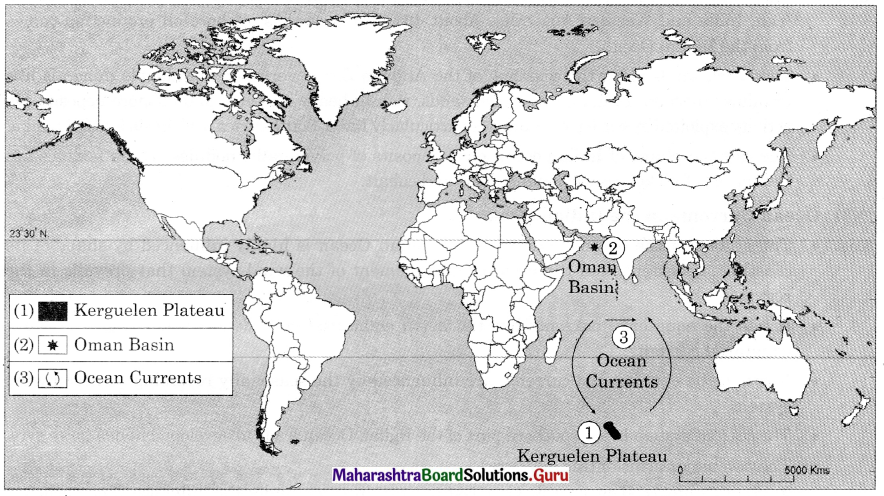
Question 1.
Name the plateau in South Indian Ocean.
Answer:
Kerguelen Plateau
Question 2.
Name the ocean basin in North Arabian Sea.
Answer:
Oman Basin
![]()
Question 3.
Name the ocean current near the equator in the Indian Ocean.
Answer:
Counter Equator Current
Question 4.
Name the ocean current in Western Indian Ocean.
Answer:
Agulhas Current
Question 5.
Name the ocean current in Eastern Indian Ocean.
Answer:
Australian Current
Write short notes on.
Question 1.
Challenges in the Indian Ocean
Answer:
- India occupies a central and strategic location in the Indian Ocean.
- Keeping the Indian Ocean as a Zone of Peace free from superpower rivalry is a major challenge in the Indian Ocean.
- Most of the conflicts since the end of the Cold War have taken place in or around the Indian Ocean region. As a result, almost all the world’s major powers have deployed substantial military forces in the Indian Ocean region.
- Expanding markets and larger import flows imply vulnerability at sea. Hence, the incidence of piracy, armed robbery and maritime terrorism are on the rise and has placed a premium on the complexity of Sea lane defence.
Question 2.
Islands in Indian Ocean
Answer:
- There are 39 islands in the Indian Ocean. Most of them are away from the coastline. They are deep sea islands.
- The islands of the Indian Ocean are a varied collection, including many smallest territories and some large islands like Sri Lanka, Australia and Madagascar.
The islands in the Indian Ocean are grouped into-
- Islands of Arabian sea
- Islands along Bay of Bengal
- Islands along the Australian coast
Islands in Indian Ocean-
- Islands of the Arabian Sea can be sub grouped such as islands close to the African coast and islands along the Lakshadweep – Chagos Ridge.
- The largest island close to the African coast is Madagascar island. It is separated from Africa, and later from the Indo-Australian plate. It is one of the seismologically active provinces.
- There are many islands between the eastern coast of Africa and Madagascar island, such as Comoros, Europa and Bassas de India, etc. To the east of Madagascar are Mauritius, Reunion and Seychelles, etc.
- The group of islands along Lakshadweep-Chagos Ridge are Maldives, Chagos and Lakshadweep.
- Apart from these islands, other islands are the Bundle island near the coast of Pakistan and Siri, Lavan, Kish, Hendorabi, etc., along the Persian Gulf part of Iran.
- The islands in Bay of Bengal are associated with the converging plate boundary. These islands are the peaks of submerged mountains. The islands of Bay of Bengal are Sri Lanka, Andaman and Nicobar group, and chain of islands along the western coast of Sumatra island of Indonesia.
- Most of these islands are volcanic islands. Sri Lanka is the largest island of this group.
- There are very few islands along the coastline of Australia such as Cacos, Christmas, Ashmore, etc.
![]()
Answer in detail.
Question 1.
Describe the continental shelf of the Indian Ocean.
Answer:
- The continental shelf is the portion of continents submerged under oceanic water.
- It is normally occupied by different gulfs, seas, bays and straits.
- There is a wide range of variation in the continental shelves of the Indian Ocean.
- There are quite extensive shelves along the Indian coasts.
- The eastern coast of Africa and Madagascar record relatively narrow width of continental shelves, and along the Indonesian coast, it is very narrow (160 km).
- The continental shelves are very wide in the west of India whereas these are narrow along the eastern coast.
- Continental shelves are veneered with deposits brought down by terrestrial agents of erosion.
- Some of the sedimentary deposits are received from over thousand years.
- As they remain deposited for a long time, sedimentary rocks are formed.
- Some of them are a potential source of fossil fuel.
Question 2.
Describe the Mid-Oceanic Ridges of the Indian Ocean.
Answer:
- Mid-oceanic ridges are submerged mountain ranges that separate deep portion of the sea (Ocean) floor.
- The Indian Ocean has a Mid Ocean ridge called as a Mid Indian Oceanic Ridge.
- It originates from the Gulf of Eden near the Peninsula of Somalia.
- It further extends toward the south and on the eastern side of Madagascar, it divides into two branches.
- One branch diverts towards southwest and extends up to Prince Edward Island. It is known as Southwest Indian Ocean Ridge.
- The second branch extends south eastwards up to Amsterdam and St. Paul Island. It is known as Mid Indian Ocean Ridge.
- Mid Indian Oceanic Ridge has many parallel ridges. This ridge is not continuous due to many fracture Zones in it. e.g. Owen Fracture Zone. Amsterdam Fracture Zone, etc.
![]()
Question 3.
Explain in detail the importance of Indian Ocean to India.
Answer:
India has the control and strategic location in the Indian Ocean. Therefore, India’s economic and national interests are linked with the Indian Ocean.
From economic point of view, India’s trade with neighbouring countries is dependent on the Indian Ocean. Indian Ocean provides major sea route connecting Middle East, Africa and East Asia with Europe and America. India’s import of mineral oil mainly comes from Gulf countries.
The sand on the beaches along the Arabian Sea is rich in valuable minerals like uranium. India has offshore deposits of mineral oil at Bombay High in the Arabian Sea. Abyssal plains of the Indian Ocean have deposit of polymetallic nodules. These nodules are source of nickel, copper, manganese and cobalt.
India has developed very good trade relations with countries of east due to its location along the Arabian Sea. Trade volumes with ASEAN countries are increasing every year. The Indian market has emerged as one of the largest importers of South East Asian goods. India also has Free Trade Agreements with Singapore and Thailand.
The northern area of the Indian Ocean is the area of great significance in economic and strategic terms. With expansion of India’s export and import, India is forecasted to become one of the three fastest growing economics in the world.
Due to heavy trade, through Indian Ocean, the incidences of piracy, armed robbery and maritime terrorism are on the rise and therefore, defence work in the Indian Ocean have increased.
To keep the Indian Ocean as a zone of peace, free from superpower rivalry and increasing cooperation among littoral countries in the region has always been India’s foreign policy goal. For example, Indian Ocean Rim Association for Regional Cooperation, Ganga-Mekong Cooperation, etc.

